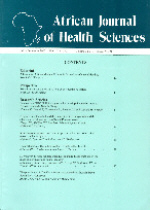
|
African Journal of Health Sciences
The Kenya Medical Research Institute (KEMRI)
ISSN: 1022-9272
Vol. 13, Num. 3-4, 2006, pp. i
|
African Journal of Health Sciences, Vol. 13, No. 3-4, July-Dec, 2006, pp. i
Editorial
The challenge of industrial production of African traditional medicines
Code Number: jh06021
Towards the end of the last century, the enormous commercial circulation of herbal products worldwide resulted in an intense interest to develop African traditional medicines for monetary gain. But, will this approach lead to the achievement of the Regional Strategy, that of incorporating African traditional medicine in the health systems of member states in the WHO African Region? The later goal would require the production of therapeutic agents that would meet the essential pharmaceutical criteria of identity, safety, and efficacy. These criteria are achievable provided that the manufacturers of these products make the effort to develop products whose identity can be identified qualitatively and quantitatively in a reproducible manner. The manufacturer must develop methods of identifying the product, and also produce methods of determining the quantitative estimation of the activity of the product. The manufacturer must also establish the safety and efficacy of the product for the indications for its intended application through clinical trials of the standardized formulation. If a traditional medicine has been used in the communities for over 30 years, then the usual rigorous pre-clinical tests would not be necessary, but appropriate ethnomedical evidence as described in the WHO/AFRO Guidelines on the collection of ethnomedical evidence is required. The manufacturer must therefore invest in both human and material resources to achieve these criteria for each product manufactured. These are the challenges, because the ethnomedical claims for a medicinal plant or preparation thereof do not provide sufficient basis for the use in human therapeutics. The physician would need to be provided with evidence of identity, safety and efficacy in order to prescribe the product for a patient.
A medicinal plant is not a drug or a medicine until it has been converted through pharmaceutical design to satisfy the criteria of identity, efficacy and safety. At best, the plant is only the raw material. The design or formulation of a traditional medicine does not necessarily mean extraction of active ingredients. It means the preparation of the medicinal product according to African traditions in a standardized and reproducible manner. The herbal products, which are currently in commercial circulation, may not meet these criteria in order that the physician can prescribe them. However, it is possible to integrate the African traditional medical know-how with modern pharmaceutical science to produce acceptable therapeutic products. The WHO/AFRO has designed guidelines for achieving these objectives. This is our challenge and we must make products that the African medical doctor can feel confident to prescribe. We can then make these traditional medicines accessible and affordable to the people living in the region. It is only then that we can move towards achieving the Regional Strategy as developed by the WHO Regional Office for Africa.
Mawuli Kofi-Tsekpo, PhD
Kenya Medical Research Institute
Copyright 2006 - African Forum for Health Sciences
|
